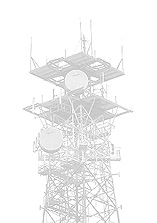|
617 NW 20th Avenue Gainesville, Florida 32609 Tel: 352.367.1700 |

|

|
|
What is a master database? A master database is a compilation of all FCC data used by rfInvestigator-FM. A master database can be built by DB-Builder or can be purchased from rfSoftware. The FCC generally updates their database each work day. What is a job? A job contains a subset of the master database. Jobs are built by rfInvestigator-FM. Station and map data within a 350 km radius of a location are included. This data allows for the study of a class C station within 60 km of the center of a job (49 km if next to the Canadian border). Lower powered classes can be studied further from the job center. What are MDAC and DCOM? Microsoft® Data Access Components (MDAC) contains database access and manipulation tools. Distributed Component Object Model (DCOM) allow different components of rfInvestigator-FM to communicate with each other. Neither DCOM nor MDAC are parts of rfInvestigator-FM, rather they are extensions of the Windows Operating System. What is the difference between Spread Census Data and Block Data? Census Blocks are reference points used by the US Census. The population and various demographics for each block are available to the public. Spread data refers to information that is assumed to be homogeneously (evenly) distributed over a given area. Before personal computers were in common use engineers would calculate the population inside a contour by manually determining the percent area covered of a city or county by that contour. The population of the city or county was considered to be distributed homogeneously, so the percentage of area covered could be used to determine the population covered. The FCC rule that described this method of spreading population ended with the statement "...more detailed population data may be used." As computers became more common, methods were developed to emulate this spreading technique under the assumption that they would produce "more detailed data". An exact replication of the manual process was impractical on a computer, so the country was divided into a grid of equal sized "bins" and the population spread over each bin was determined. RFInvestigator uses 860 30-second (900-meter) bins to spread the 2000 Census data. The 2010 data is spread into 9,475 12-second (360-meter) bins.The most detailed data available are census blocks. There are 11,155,486 blocks in the 2010 US Census and 8,262,363 in the 2000 Census. Computers are now powerful enough to skip the spreading techniques and simply count as in or out of a contour individual census blocks. See this page: Population Data for more information.What is the difference between the various terrain databases? See this page: Terrain Differences | ||

|
|
rfSoftware | About | Features | Screenshots | FAQ | Pricing | Dealers | Downloads rfDetective-FM | rfInvestigator-FM | rfProfiler Light Copyright © 2004-2012, rfSoftware, Inc. |